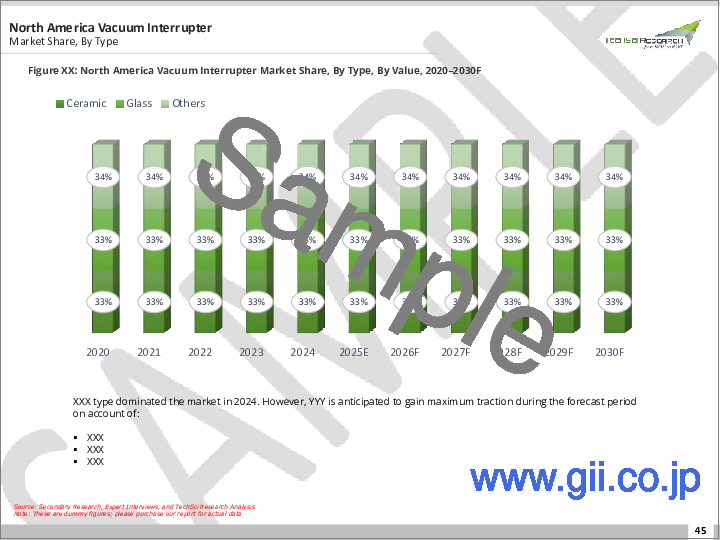|
|
市場調査レポート
商品コード
1763951
真空バルブ市場- 世界の産業規模、シェア、動向、機会、予測、設計タイプ別、最終用途別、用途別、地域別セグメント、競合、2020年~2030年Vacuum Interrupter Market - Global Industry Size, Share, Trends, Opportunity, and Forecast, Segmented By Design Type, By End Use, By Application, By Region, By Competition, 2020-2030F |
||||||
カスタマイズ可能
|
|||||||
| 真空バルブ市場- 世界の産業規模、シェア、動向、機会、予測、設計タイプ別、最終用途別、用途別、地域別セグメント、競合、2020年~2030年 |
|
出版日: 2025年06月30日
発行: TechSci Research
ページ情報: 英文 188 Pages
納期: 2~3営業日
|
全表示
- 概要
- 目次
真空バルブの世界市場規模は、2024年に33億米ドル、2030年には43億米ドルに達し、CAGR 4.5%で成長すると予測されています。
この成長は、特に老朽化した電気インフラをアップグレードする取り組みの中で、効率的で信頼性の高い配電に対する世界の需要が増加していることが背景にあります。新興国における都市化と工業化により、中高圧機器の必要性が高まっており、真空バルブはアーク消弧効率と低メンテナンス要件により不可欠です。また、再生可能エネルギーへのシフトが進んでおり、真空バルブが太陽光発電、風力発電、蓄電システムのスイッチング動作をサポートするため、採用が加速しています。政府によるスマートグリッド構想への投資や、SF6ベースの技術に代わる環境に優しい技術も、市場の拡大をさらに加速しています。加えて、設計の小型化と耐用年数の延長が進み、サーキットブレーカ、リクローザ、コンタクタの展開が拡大しています。EVインフラ、データセンター、デジタル化による電力消費の増加は、真空バルブの新たな応用機会を世界的に拡大し続けています。
| 市場概要 | |
|---|---|
| 予測期間 | 2026-2030 |
| 市場規模:2024年 | 33億米ドル |
| 市場規模:2030年 | 43億米ドル |
| CAGR:2025年~2030年 | 4.5% |
| 急成長セグメント | シングルブレーク |
| 最大市場 | 北米 |
市場促進要因
送電網の近代化と再生可能エネルギーの統合
主な市場課題
初期コストの高さと資本集約的な製造
主要市場動向
スマートグリッドとデジタルスイッチギア技術の急速な普及
目次
第1章 概要
第2章 調査手法
第3章 エグゼクティブサマリー
第4章 顧客の声
第5章 世界の真空バルブ市場展望
- 市場規模・予測
- 金額別
- 市場シェア・予測
- 設計タイプ別(シングルブレーク、ダブルブレーク、マルチブレーク)
- 用途別(発電、送電・配電、産業用途、再生可能エネルギー、その他)
- 最終用途別(ユーティリティ、製造、商業、住宅、その他)
- 地域別(北米、欧州、南米、中東・アフリカ、アジア太平洋)
- 企業別(2024)
- 市場マップ
第6章 北米の真空バルブ市場展望
- 市場規模・予測
- 市場シェア・予測
- 北米:国別分析
- 米国
- カナダ
- メキシコ
第7章 欧州の真空バルブ市場展望
- 市場規模・予測
- 市場シェア・予測
- 欧州:国別分析
- ドイツ
- フランス
- 英国
- イタリア
- スペイン
第8章 アジア太平洋地域の真空バルブ市場展望
- 市場規模・予測
- 市場シェア・予測
- アジア太平洋地域:国別分析
- 中国
- インド
- 日本
- 韓国
- オーストラリア
第9章 中東・アフリカの真空バルブ市場展望
- 市場規模・予測
- 市場シェア・予測
- 中東・アフリカ:国別分析
- サウジアラビア
- アラブ首長国連邦
- 南アフリカ
第10章 南米の真空バルブ市場展望
- 市場規模・予測
- 市場シェア・予測
- 南米:国別分析
- ブラジル
- コロンビア
- アルゼンチン
第11章 市場力学
- 促進要因
- 課題
第12章 市場動向と発展
- 合併と買収
- 製品上市
- 最近の動向
第13章 企業プロファイル
- ABB Ltd.
- Eaton Corporation plc
- General Electric Company
- Siemens AG
- Toshiba Corporation
- Meidensha Corporation
- Schneider Electric SE
- Mitsubishi Electric Corporation
第14章 戦略的提言
第15章 調査会社について・免責事項
The Global Vacuum Interrupter Market was valued at USD 3.3 billion in 2024 and is projected to reach USD 4.3 billion by 2030, growing at a CAGR of 4.5%. This growth is fueled by increasing global demand for efficient and reliable power distribution, particularly amid efforts to upgrade aging electrical infrastructure. Urbanization and industrialization in emerging economies are intensifying the need for medium- and high-voltage equipment, where vacuum interrupters are vital due to their arc-quenching efficiency and low maintenance requirements. The ongoing shift toward renewable energy is also boosting adoption, as vacuum interrupters support switching operations in solar, wind, and storage systems. Governments' investments in smart grid initiatives and eco-friendly alternatives to SF6-based technologies are further accelerating market expansion. In addition, advancements in design compactness and extended service life are enhancing deployment across circuit breakers, reclosers, and contactors. Rising electricity consumption-driven by EV infrastructure, data centers, and digitization-continues to unlock new application opportunities for vacuum interrupters globally.
| Market Overview | |
|---|---|
| Forecast Period | 2026-2030 |
| Market Size 2024 | USD 3.3 Billion |
| Market Size 2030 | USD 4.3 Billion |
| CAGR 2025-2030 | 4.5% |
| Fastest Growing Segment | Single Break |
| Largest Market | North America |
Key Market Drivers
Grid Modernization and Renewable Energy Integration
The ongoing modernization of electrical grids and growing integration of renewable energy sources are key drivers boosting the vacuum interrupter market. Developed economies such as the U.S., Germany, the UK, and Japan are transitioning to smarter, more efficient grids equipped with real-time monitoring and automation. In these modern networks, vacuum interrupters serve as reliable and eco-friendly components, replacing traditional SF6-based breakers. Simultaneously, the increasing adoption of variable renewable energy sources like solar and wind demands dynamic and efficient switching technologies. Vacuum interrupters, known for rapid arc extinguishing and durability in diverse conditions, are highly suited for managing the variability of renewable generation. Their minimal maintenance needs and high operational reliability make them ideal for use in distributed energy systems, further strengthening their role in modern power infrastructure.
Key Market Challenges
High Initial Costs and Capital-Intensive Manufacturing
A significant challenge in the vacuum interrupter market is the high initial cost involved in production and deployment. These devices require precision engineering and specialized materials such as ceramics and metal alloys, along with sophisticated manufacturing infrastructure. As a result, vacuum interrupters typically cost more upfront compared to traditional alternatives, especially in low- and medium-voltage applications. Cost constraints are especially relevant in developing countries, where budget-conscious utility and electrification projects may favor less expensive but higher-maintenance technologies. Additionally, limited production scale for specialized interrupter designs often leads to higher per-unit costs, making it difficult for smaller manufacturers to compete with global players that benefit from advanced production capabilities and economies of scale.
Key Market Trends
Rapid Adoption of Smart Grid and Digital Switchgear Technologies
The swift shift toward smart grid deployment and digital switchgear solutions is reshaping the vacuum interrupter market. Utilities are increasingly incorporating sensors, digital control units, and communication technologies to enable real-time diagnostics, automated fault detection, and predictive maintenance. Vacuum interrupters are well-suited for integration into such digital systems due to their high reliability, compact form factor, and low maintenance. Unlike conventional breakers that require manual servicing, vacuum interrupters equipped with smart diagnostics can alert operators to abnormal conditions, minimizing downtime. National grid modernization programs in countries like China, the U.S., and Germany are further accelerating the shift from legacy systems to smart infrastructure, positioning vacuum interrupters as a standard component in future-ready electrical networks.
Key Market Players
- ABB Ltd.
- Eaton Corporation plc
- General Electric Company
- Siemens AG
- Toshiba Corporation
- Meidensha Corporation
- Schneider Electric SE
- Mitsubishi Electric Corporation
Report Scope:
In this report, the Global Vacuum Interrupter Market has been segmented into the following categories, in addition to the industry trends which have also been detailed below:
Vacuum Interrupter Market, By Design Type:
- Single Break
- Double Break
- Multiple Break
Vacuum Interrupter Market, By Application:
- Power Generation
- Transmission & Distribution
- Industrial Applications
- Renewable Energy
- Others
Vacuum Interrupter Market, By End Use:
- Utilities
- Manufacturing
- Commercial
- Residential
- Others
Vacuum Interrupter Market, By Region:
- North America
- United States
- Canada
- Mexico
- Europe
- Germany
- France
- United Kingdom
- Italy
- Spain
- Asia Pacific
- China
- India
- Japan
- South Korea
- Australia
- South America
- Brazil
- Colombia
- Argentina
- Middle East & Africa
- Saudi Arabia
- UAE
- South Africa
Competitive Landscape
Company Profiles: Detailed analysis of the major companies present in the Global Vacuum Interrupter Market.
Available Customizations:
Global Vacuum Interrupter Market report with the given market data, TechSci Research offers customizations according to a company's specific needs. The following customization options are available for the report:
Company Information
- Detailed analysis and profiling of additional market players (up to five).
Table of Contents
1. Product Overview
- 1.1. Market Definition
- 1.2. Scope of the Market
- 1.2.1. Markets Covered
- 1.2.2. Years Considered for Study
- 1.2.3. Key Market Segmentations
2. Research Methodology
- 2.1. Objective of the Study
- 2.2. Baseline Methodology
- 2.3. Key Industry Partners
- 2.4. Major Association and Secondary Sources
- 2.5. Forecasting Methodology
- 2.6. Data Triangulation & Validation
- 2.7. Assumptions and Limitations
3. Executive Summary
- 3.1. Overview of the Market
- 3.2. Overview of Key Market Segmentations
- 3.3. Overview of Key Market Players
- 3.4. Overview of Key Regions/Countries
- 3.5. Overview of Market Drivers, Challenges, and Trends
4. Voice of Customer
5. Global Vacuum Interrupter Market Outlook
- 5.1. Market Size & Forecast
- 5.1.1. By Value
- 5.2. Market Share & Forecast
- 5.2.1. By Design Type (Single Break, Double Break, Multiple Break)
- 5.2.2. By Application (Power Generation, Transmission & Distribution, Industrial Applications, Renewable Energy, Others)
- 5.2.3. By End Use (Utilities, Manufacturing, Commercial, Residential, Others)
- 5.2.4. By Region (North America, Europe, South America, Middle East & Africa, Asia Pacific)
- 5.3. By Company (2024)
- 5.4. Market Map
6. North America Vacuum Interrupter Market Outlook
- 6.1. Market Size & Forecast
- 6.1.1. By Value
- 6.2. Market Share & Forecast
- 6.2.1. By Design Type
- 6.2.2. By Application
- 6.2.3. By End Use
- 6.2.4. By Country
- 6.3. North America: Country Analysis
- 6.3.1. United States Vacuum Interrupter Market Outlook
- 6.3.1.1. Market Size & Forecast
- 6.3.1.1.1. By Value
- 6.3.1.2. Market Share & Forecast
- 6.3.1.2.1. By Design Type
- 6.3.1.2.2. By Application
- 6.3.1.2.3. By End Use
- 6.3.1.1. Market Size & Forecast
- 6.3.2. Canada Vacuum Interrupter Market Outlook
- 6.3.2.1. Market Size & Forecast
- 6.3.2.1.1. By Value
- 6.3.2.2. Market Share & Forecast
- 6.3.2.2.1. By Design Type
- 6.3.2.2.2. By Application
- 6.3.2.2.3. By End Use
- 6.3.2.1. Market Size & Forecast
- 6.3.3. Mexico Vacuum Interrupter Market Outlook
- 6.3.3.1. Market Size & Forecast
- 6.3.3.1.1. By Value
- 6.3.3.2. Market Share & Forecast
- 6.3.3.2.1. By Design Type
- 6.3.3.2.2. By Application
- 6.3.3.2.3. By End Use
- 6.3.3.1. Market Size & Forecast
- 6.3.1. United States Vacuum Interrupter Market Outlook
7. Europe Vacuum Interrupter Market Outlook
- 7.1. Market Size & Forecast
- 7.1.1. By Value
- 7.2. Market Share & Forecast
- 7.2.1. By Design Type
- 7.2.2. By Application
- 7.2.3. By End Use
- 7.2.4. By Country
- 7.3. Europe: Country Analysis
- 7.3.1. Germany Vacuum Interrupter Market Outlook
- 7.3.1.1. Market Size & Forecast
- 7.3.1.1.1. By Value
- 7.3.1.2. Market Share & Forecast
- 7.3.1.2.1. By Design Type
- 7.3.1.2.2. By Application
- 7.3.1.2.3. By End Use
- 7.3.1.1. Market Size & Forecast
- 7.3.2. France Vacuum Interrupter Market Outlook
- 7.3.2.1. Market Size & Forecast
- 7.3.2.1.1. By Value
- 7.3.2.2. Market Share & Forecast
- 7.3.2.2.1. By Design Type
- 7.3.2.2.2. By Application
- 7.3.2.2.3. By End Use
- 7.3.2.1. Market Size & Forecast
- 7.3.3. United Kingdom Vacuum Interrupter Market Outlook
- 7.3.3.1. Market Size & Forecast
- 7.3.3.1.1. By Value
- 7.3.3.2. Market Share & Forecast
- 7.3.3.2.1. By Design Type
- 7.3.3.2.2. By Application
- 7.3.3.2.3. By End Use
- 7.3.3.1. Market Size & Forecast
- 7.3.4. Italy Vacuum Interrupter Market Outlook
- 7.3.4.1. Market Size & Forecast
- 7.3.4.1.1. By Value
- 7.3.4.2. Market Share & Forecast
- 7.3.4.2.1. By Design Type
- 7.3.4.2.2. By Application
- 7.3.4.2.3. By End Use
- 7.3.4.1. Market Size & Forecast
- 7.3.5. Spain Vacuum Interrupter Market Outlook
- 7.3.5.1. Market Size & Forecast
- 7.3.5.1.1. By Value
- 7.3.5.2. Market Share & Forecast
- 7.3.5.2.1. By Design Type
- 7.3.5.2.2. By Application
- 7.3.5.2.3. By End Use
- 7.3.5.1. Market Size & Forecast
- 7.3.1. Germany Vacuum Interrupter Market Outlook
8. Asia Pacific Vacuum Interrupter Market Outlook
- 8.1. Market Size & Forecast
- 8.1.1. By Value
- 8.2. Market Share & Forecast
- 8.2.1. By Design Type
- 8.2.2. By Application
- 8.2.3. By End Use
- 8.2.4. By Country
- 8.3. Asia Pacific: Country Analysis
- 8.3.1. China Vacuum Interrupter Market Outlook
- 8.3.1.1. Market Size & Forecast
- 8.3.1.1.1. By Value
- 8.3.1.2. Market Share & Forecast
- 8.3.1.2.1. By Design Type
- 8.3.1.2.2. By Application
- 8.3.1.2.3. By End Use
- 8.3.1.1. Market Size & Forecast
- 8.3.2. India Vacuum Interrupter Market Outlook
- 8.3.2.1. Market Size & Forecast
- 8.3.2.1.1. By Value
- 8.3.2.2. Market Share & Forecast
- 8.3.2.2.1. By Design Type
- 8.3.2.2.2. By Application
- 8.3.2.2.3. By End Use
- 8.3.2.1. Market Size & Forecast
- 8.3.3. Japan Vacuum Interrupter Market Outlook
- 8.3.3.1. Market Size & Forecast
- 8.3.3.1.1. By Value
- 8.3.3.2. Market Share & Forecast
- 8.3.3.2.1. By Design Type
- 8.3.3.2.2. By Application
- 8.3.3.2.3. By End Use
- 8.3.3.1. Market Size & Forecast
- 8.3.4. South Korea Vacuum Interrupter Market Outlook
- 8.3.4.1. Market Size & Forecast
- 8.3.4.1.1. By Value
- 8.3.4.2. Market Share & Forecast
- 8.3.4.2.1. By Design Type
- 8.3.4.2.2. By Application
- 8.3.4.2.3. By End Use
- 8.3.4.1. Market Size & Forecast
- 8.3.5. Australia Vacuum Interrupter Market Outlook
- 8.3.5.1. Market Size & Forecast
- 8.3.5.1.1. By Value
- 8.3.5.2. Market Share & Forecast
- 8.3.5.2.1. By Design Type
- 8.3.5.2.2. By Application
- 8.3.5.2.3. By End Use
- 8.3.5.1. Market Size & Forecast
- 8.3.1. China Vacuum Interrupter Market Outlook
9. Middle East & Africa Vacuum Interrupter Market Outlook
- 9.1. Market Size & Forecast
- 9.1.1. By Value
- 9.2. Market Share & Forecast
- 9.2.1. By Design Type
- 9.2.2. By Application
- 9.2.3. By End Use
- 9.2.4. By Country
- 9.3. Middle East & Africa: Country Analysis
- 9.3.1. Saudi Arabia Vacuum Interrupter Market Outlook
- 9.3.1.1. Market Size & Forecast
- 9.3.1.1.1. By Value
- 9.3.1.2. Market Share & Forecast
- 9.3.1.2.1. By Design Type
- 9.3.1.2.2. By Application
- 9.3.1.2.3. By End Use
- 9.3.1.1. Market Size & Forecast
- 9.3.2. UAE Vacuum Interrupter Market Outlook
- 9.3.2.1. Market Size & Forecast
- 9.3.2.1.1. By Value
- 9.3.2.2. Market Share & Forecast
- 9.3.2.2.1. By Design Type
- 9.3.2.2.2. By Application
- 9.3.2.2.3. By End Use
- 9.3.2.1. Market Size & Forecast
- 9.3.3. South Africa Vacuum Interrupter Market Outlook
- 9.3.3.1. Market Size & Forecast
- 9.3.3.1.1. By Value
- 9.3.3.2. Market Share & Forecast
- 9.3.3.2.1. By Design Type
- 9.3.3.2.2. By Application
- 9.3.3.2.3. By End Use
- 9.3.3.1. Market Size & Forecast
- 9.3.1. Saudi Arabia Vacuum Interrupter Market Outlook
10. South America Vacuum Interrupter Market Outlook
- 10.1. Market Size & Forecast
- 10.1.1. By Value
- 10.2. Market Share & Forecast
- 10.2.1. By Design Type
- 10.2.2. By Application
- 10.2.3. By End Use
- 10.2.4. By Country
- 10.3. South America: Country Analysis
- 10.3.1. Brazil Vacuum Interrupter Market Outlook
- 10.3.1.1. Market Size & Forecast
- 10.3.1.1.1. By Value
- 10.3.1.2. Market Share & Forecast
- 10.3.1.2.1. By Design Type
- 10.3.1.2.2. By Application
- 10.3.1.2.3. By End Use
- 10.3.1.1. Market Size & Forecast
- 10.3.2. Colombia Vacuum Interrupter Market Outlook
- 10.3.2.1. Market Size & Forecast
- 10.3.2.1.1. By Value
- 10.3.2.2. Market Share & Forecast
- 10.3.2.2.1. By Design Type
- 10.3.2.2.2. By Application
- 10.3.2.2.3. By End Use
- 10.3.2.1. Market Size & Forecast
- 10.3.3. Argentina Vacuum Interrupter Market Outlook
- 10.3.3.1. Market Size & Forecast
- 10.3.3.1.1. By Value
- 10.3.3.2. Market Share & Forecast
- 10.3.3.2.1. By Design Type
- 10.3.3.2.2. By Application
- 10.3.3.2.3. By End Use
- 10.3.3.1. Market Size & Forecast
- 10.3.1. Brazil Vacuum Interrupter Market Outlook
11. Market Dynamics
- 11.1. Drivers
- 11.2. Challenges
12. Market Trends and Developments
- 12.1. Merger & Acquisition (If Any)
- 12.2. Product Launches (If Any)
- 12.3. Recent Developments
13. Company Profiles
- 13.1. ABB Ltd.
- 13.1.1. Business Overview
- 13.1.2. Key Revenue and Financials
- 13.1.3. Recent Developments
- 13.1.4. Key Personnel
- 13.1.5. Key Product/Services Offered
- 13.2. Eaton Corporation plc
- 13.3. General Electric Company
- 13.4. Siemens AG
- 13.5. Toshiba Corporation
- 13.6. Meidensha Corporation
- 13.7. Schneider Electric SE
- 13.8. Mitsubishi Electric Corporation




